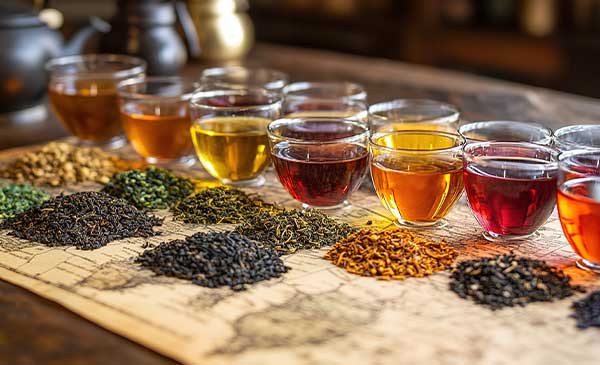The Art of Tea Tasting: A Journey for the Senses

Tea tasting is more than just sipping a warm beverage—it's an exploration of aroma, flavor, texture, and origin. Much like wine or coffee connoisseurship, tea tasting is both an art and a science.
This tea ceremony invites the drinker to slow down, be present. Experience the essence of leaves that have traveled from distant hillsides and ancient gardens into your cup.
Whether you're a seasoned tea enthusiast or just beginning your journey, learning the art of tea tasting can deepen your appreciation for every brew. This guide will help you discover how to taste tea properly, what to look for in each variety, and how to elevate your tasting experience.
What Is Tea Tasting?
Tea tasting is the process of evaluating tea based on its sensory characteristics:
- Appearance
- Tea aroma
- Flavor
- Mouthfeel
- Aftertaste
Professional tea tasters, often referred to as “tea sommeliers” or “tea masters,” use standardized methods. This helps them compare teas from different regions, harvests, and production styles.
Formal tasting protocols exist in the tea industry (especially for grading and auction purposes). But anyone can learn the basics and enjoy tasting tea more thoughtfully at home.
Why Taste Tea Mindfully?
Tasting tea mindfully allows you to:
- Identify the nuances of different types of tea—green, black, oolong, white, puerh, herbal, and chai blends.
- Appreciate origin and craftsmanship, such as the terroir (climate, soil, altitude) and processing techniques.
- Refine your palate and understand your personal preferences.
- Pair teas better with food or mood, elevating everyday rituals into sensory experiences.

Preparing for a Tea Tasting Session
Before you begin, set the stage for a proper tasting:
Choose Your Teas
Select 2 to 5 different teas to compare. You might choose:
- Same type, different regions (e.g., Sencha vs. Dragonwell, assam tea vs. ceylon)
- Same region, different styles (e.g., Indian Darjeeling first flush vs. second flush)
- A range of camellia sinensis teas such as green, black, oolong, etc. You can also include herbal and rooibos teas.)

Use Good Water
Since tea is 98% water, the quality of water matters. Use filtered or spring water to avoid chlorine or mineral interference.
Standardize Your Equipment
Use white or clear cups, a neutral background, and the same brewing vessel (like a gaiwan or glass teapot). Keep measurements consistent—1 teaspoon of leaves per 8 oz cup is a common ratio, adjusted for tea type.
Brew Properly
Time and temperature vary by tea type. Here’s a quick reference:
- Green tea: 160–180°F for 1–3 minutes
- White tea: 175–185°F for 3–5 minutes
- Oolong tea: 185–205°F for 3–5 minutes
- Black tea: 200–212°F for 3–5 minutes
- Puerh: 200–212°F for 2–5 minutes
- Herbal teas: 205–212°F for 5–7 minutes
Use a timer and thermometer if needed. Consistency ensures fair comparison.
The Five Senses of Tea Tasting
Tea tasting engages all five senses. Let’s break it down:
1. Appearance
Observe the dry leaves first. Look at:
- Shape: Are they twisted, rolled, needle-like, crumbled?
- Color: Bright green? Golden tips? Silvery buds?
- Size: Uniform or mixed?
Next, after steeping, note the wet leaves. High-quality loose leaf tea often reveals whole or mostly intact leaves, not dust or fannings as found in teabags.
Look at the liquor color (the brewed tea). A vibrant green, amber-gold, ruby-red, or deep mahogany can indicate the tea's type and strength.

2. Aroma
Before sipping, inhale deeply. Cup your hands around the rim of the cup and bring your nose close. Some teas may smell floral, grassy, smoky, fruity, nutty, or malty. Others might surprise you with hints of seaweed, chocolate, or stone fruit.
Tea aromas can be divided into:
- Dry leaf aroma
- Wet leaf aroma
- Infusion aroma (the steam from the cup)
Smell tells much about freshness, oxidation level, and complexity.
3. Taste
Take a small sip and slurp slightly to aerate the tea across your tongue. Pay attention to:
- Flavor profile: Is it vegetal, sweet, earthy, mineral, or spicy?
- Balance: Is the tea astringent, bitter, or smooth?
- Complexity: Do the flavors evolve from start to finish?
Some teas, like high-grade oolongs or puerhs, change with each steep. This transformation is part of their charm.

4. Mouthfeel
Also called the “body” or “texture,” mouthfeel describes how the tea feels in your mouth. Is it:
- Thin or thick?
- Creamy or drying?
- Silky, velvety, or gritty?
Astringency (that puckering feeling) can be pleasant in moderation and is often more noticeable in black or green teas.
5. Finish
The aftertaste or finish refers to how the flavor lingers once you swallow. Some teas leave a sweet, lingering “hui gan” (returning sweetness), while others fade quickly.
A great tea will leave a pleasant and lasting impression—often evolving even after the last sip.
Vocabulary of Tea Tasting
Describing tea accurately can be challenging. Here are a few common flavor descriptors used by tea tasters:
- Vegetal: spinach, seaweed, cut grass (often green teas)
- Fruity: peach, raisin, citrus, lychee (common in oolong or white teas)
- Nutty: chestnut, almond, roasted nuts (especially Dragonwell or genmaicha)
- Floral: jasmine, orchid, rose (white teas and Chinese oolongs)
- Malty: bread, honey, toasted grain (common in Assam and Yunnan blacks)
- Earthy: mushroom, forest floor (aged puerhs)
- Spicy: cinnamon, clove, ginger (especially in chai blends)
Keeping a tea journal can help track your impressions and vocabulary over time.
Tasting Tea Like a Pro
Professional tea tasters often use a cupping set: a lidded bowl and matching cup. They follow these steps:
- Weigh 2 grams of tea per 100 ml of water.
- Steep for a precise time (usually 3–5 minutes).
- Pour the infusion into the cup and assess.
- Slurp briskly to spray tea across the palate.
- Spit (in formal settings) to avoid caffeine overload.
These steps aren't necessary for casual tasting. You can incorporate some techniques at home to increase accuracy and appreciation.

Factors That Affect Tea Flavor
Several elements influence how a tea tastes:
- Terroir: Soil, altitude, and climate at the tea origin
- Cultivar: The specific variety of the tea plant
- Processing: Levels of oxidation, rolling, roasting, and aging
- Harvest time: Spring harvests are typically more delicate; later ones may be bolder
- Storage: Exposure to light, moisture, or odor can degrade flavor
Understanding these variables can help explain why even the same type of tea can vary from cup to cup.
Tips to Develop Your Palate
- Taste side-by-side: Tasting multiple teas at once helps highlight contrasts.
- Use a flavor wheel: Tea flavor wheels are tools that list aroma and flavor notes for easy reference.
- Attend tea tastings or workshops: Learn from others and expand your appreciation.
- Practice regularly: The more you taste, the more nuanced your perception becomes.
Conclusion: A Journey, Not a Destination
The art of tea tasting is a personal and evolving practice. You don’t need to be a certified taster to enjoy the beauty of a well-brewed cup. The more time you spend noticing the color, the rising aroma, the texture, and the layers of flavor, the richer your tea experience becomes.
So the next time you drink tea, pause and engage all your senses. Savor the present moment. You’re not just tea drinking—you’re tasting history, nature, and craftsmanship in every sip.






